Strategic Marketing Plan for Sainsbury's: A Comprehensive Analysis
VerifiedAdded on 2023/01/06
|16
|5577
|79
Report
AI Summary
This report presents a strategic marketing plan for Sainsbury's, a major UK supermarket chain. It begins with an introduction to Sainsbury's and the retail industry, followed by an environmental analysis using SWOT and PESTLE frameworks. The report then outlines the importance of setting marketing objectives and presents organizational objectives. It delves into marketing strategy, including the Ansoff Matrix, digital marketing, and cost leadership. The report further examines segmentation, targeting, and positioning strategies for Sainsbury's, followed by a discussion of the marketing mix. Finally, the report addresses the implementation and control of the strategic plan, concluding with a summary of key findings and a discussion on the strategic importance of monitoring and controlling marketing strategies. The report emphasizes the importance of adapting to the changing retail landscape and maintaining a competitive edge.
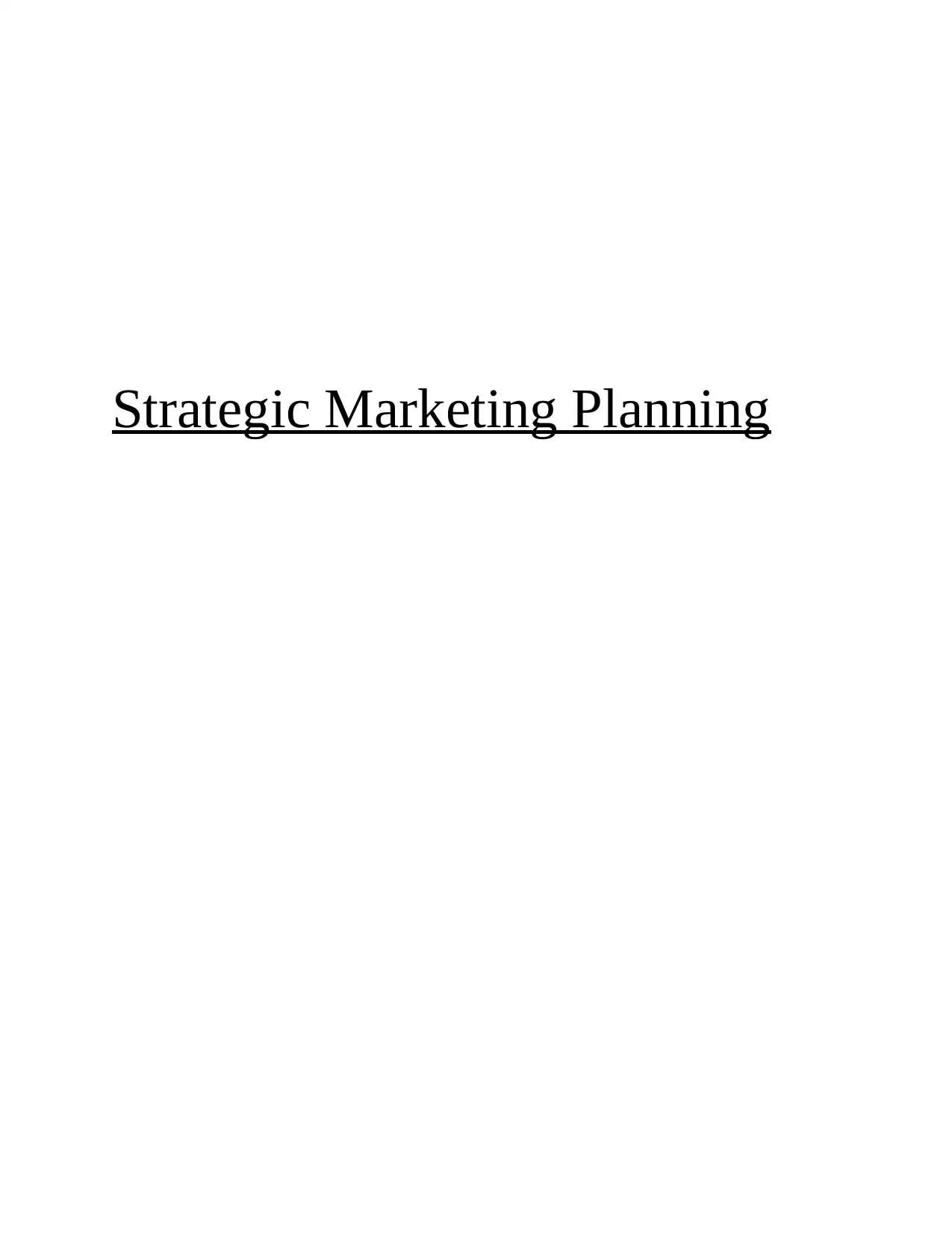
Strategic Marketing Planning
Paraphrase This Document
Need a fresh take? Get an instant paraphrase of this document with our AI Paraphraser
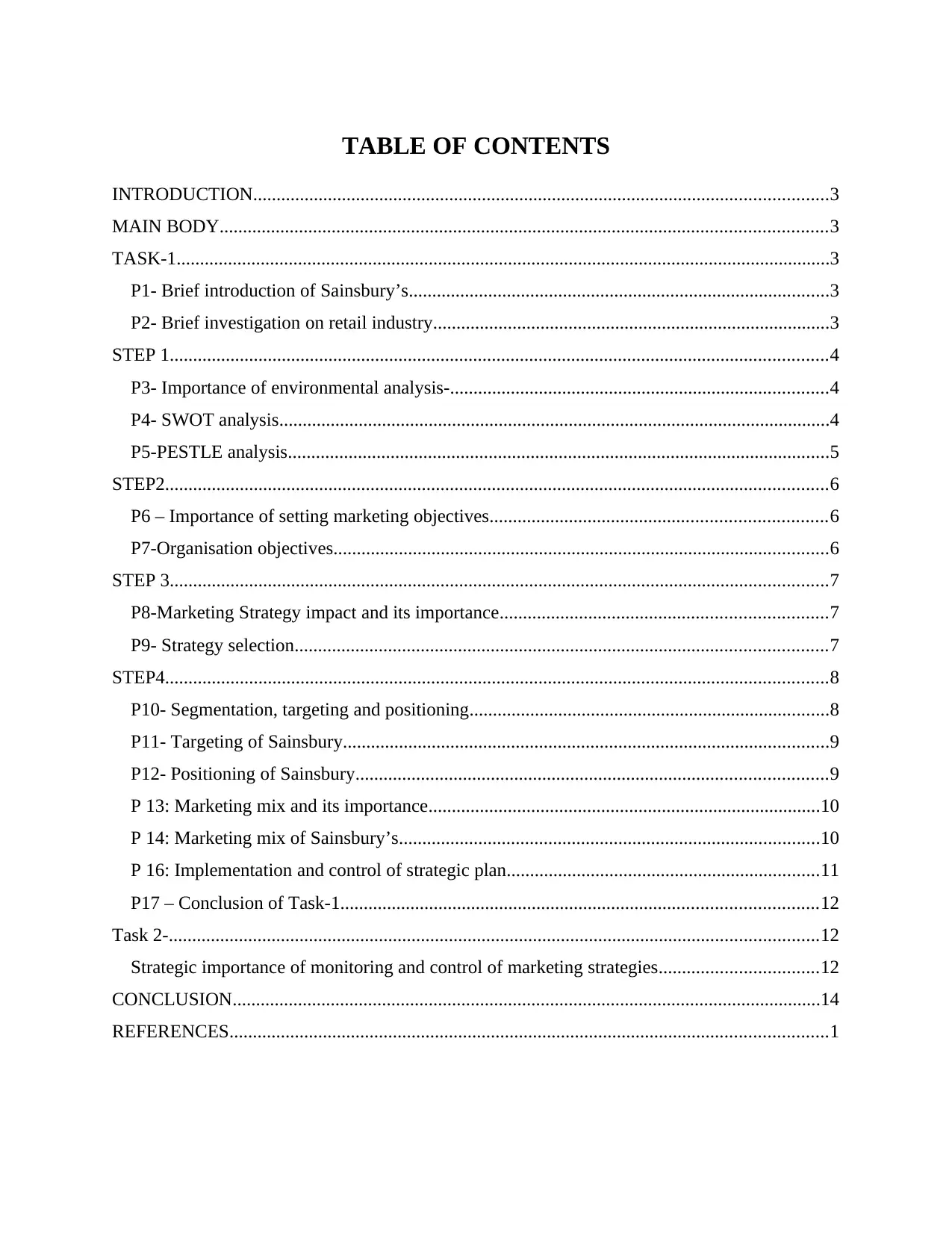
TABLE OF CONTENTS
INTRODUCTION...........................................................................................................................3
MAIN BODY..................................................................................................................................3
TASK-1............................................................................................................................................3
P1- Brief introduction of Sainsbury’s..........................................................................................3
P2- Brief investigation on retail industry.....................................................................................3
STEP 1.............................................................................................................................................4
P3- Importance of environmental analysis-.................................................................................4
P4- SWOT analysis......................................................................................................................4
P5-PESTLE analysis....................................................................................................................5
STEP2..............................................................................................................................................6
P6 – Importance of setting marketing objectives........................................................................6
P7-Organisation objectives..........................................................................................................6
STEP 3.............................................................................................................................................7
P8-Marketing Strategy impact and its importance......................................................................7
P9- Strategy selection..................................................................................................................7
STEP4..............................................................................................................................................8
P10- Segmentation, targeting and positioning.............................................................................8
P11- Targeting of Sainsbury........................................................................................................9
P12- Positioning of Sainsbury.....................................................................................................9
P 13: Marketing mix and its importance....................................................................................10
P 14: Marketing mix of Sainsbury’s..........................................................................................10
P 16: Implementation and control of strategic plan...................................................................11
P17 – Conclusion of Task-1......................................................................................................12
Task 2-...........................................................................................................................................12
Strategic importance of monitoring and control of marketing strategies..................................12
CONCLUSION..............................................................................................................................14
REFERENCES................................................................................................................................1
INTRODUCTION...........................................................................................................................3
MAIN BODY..................................................................................................................................3
TASK-1............................................................................................................................................3
P1- Brief introduction of Sainsbury’s..........................................................................................3
P2- Brief investigation on retail industry.....................................................................................3
STEP 1.............................................................................................................................................4
P3- Importance of environmental analysis-.................................................................................4
P4- SWOT analysis......................................................................................................................4
P5-PESTLE analysis....................................................................................................................5
STEP2..............................................................................................................................................6
P6 – Importance of setting marketing objectives........................................................................6
P7-Organisation objectives..........................................................................................................6
STEP 3.............................................................................................................................................7
P8-Marketing Strategy impact and its importance......................................................................7
P9- Strategy selection..................................................................................................................7
STEP4..............................................................................................................................................8
P10- Segmentation, targeting and positioning.............................................................................8
P11- Targeting of Sainsbury........................................................................................................9
P12- Positioning of Sainsbury.....................................................................................................9
P 13: Marketing mix and its importance....................................................................................10
P 14: Marketing mix of Sainsbury’s..........................................................................................10
P 16: Implementation and control of strategic plan...................................................................11
P17 – Conclusion of Task-1......................................................................................................12
Task 2-...........................................................................................................................................12
Strategic importance of monitoring and control of marketing strategies..................................12
CONCLUSION..............................................................................................................................14
REFERENCES................................................................................................................................1
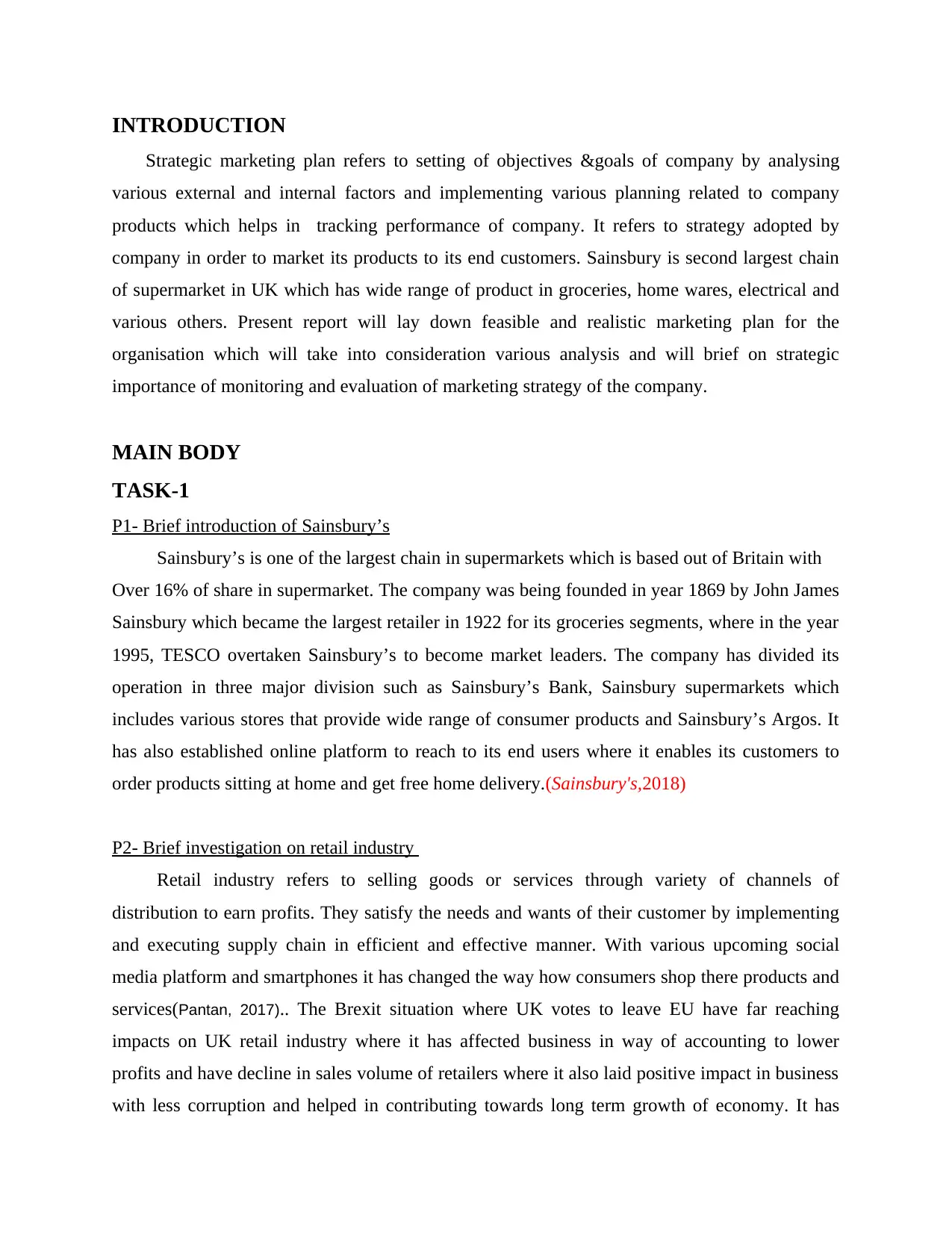
INTRODUCTION
Strategic marketing plan refers to setting of objectives &goals of company by analysing
various external and internal factors and implementing various planning related to company
products which helps in tracking performance of company. It refers to strategy adopted by
company in order to market its products to its end customers. Sainsbury is second largest chain
of supermarket in UK which has wide range of product in groceries, home wares, electrical and
various others. Present report will lay down feasible and realistic marketing plan for the
organisation which will take into consideration various analysis and will brief on strategic
importance of monitoring and evaluation of marketing strategy of the company.
MAIN BODY
TASK-1
P1- Brief introduction of Sainsbury’s
Sainsbury’s is one of the largest chain in supermarkets which is based out of Britain with
Over 16% of share in supermarket. The company was being founded in year 1869 by John James
Sainsbury which became the largest retailer in 1922 for its groceries segments, where in the year
1995, TESCO overtaken Sainsbury’s to become market leaders. The company has divided its
operation in three major division such as Sainsbury’s Bank, Sainsbury supermarkets which
includes various stores that provide wide range of consumer products and Sainsbury’s Argos. It
has also established online platform to reach to its end users where it enables its customers to
order products sitting at home and get free home delivery.(Sainsbury's,2018)
P2- Brief investigation on retail industry
Retail industry refers to selling goods or services through variety of channels of
distribution to earn profits. They satisfy the needs and wants of their customer by implementing
and executing supply chain in efficient and effective manner. With various upcoming social
media platform and smartphones it has changed the way how consumers shop there products and
services(Pantan, 2017).. The Brexit situation where UK votes to leave EU have far reaching
impacts on UK retail industry where it has affected business in way of accounting to lower
profits and have decline in sales volume of retailers where it also laid positive impact in business
with less corruption and helped in contributing towards long term growth of economy. It has
Strategic marketing plan refers to setting of objectives &goals of company by analysing
various external and internal factors and implementing various planning related to company
products which helps in tracking performance of company. It refers to strategy adopted by
company in order to market its products to its end customers. Sainsbury is second largest chain
of supermarket in UK which has wide range of product in groceries, home wares, electrical and
various others. Present report will lay down feasible and realistic marketing plan for the
organisation which will take into consideration various analysis and will brief on strategic
importance of monitoring and evaluation of marketing strategy of the company.
MAIN BODY
TASK-1
P1- Brief introduction of Sainsbury’s
Sainsbury’s is one of the largest chain in supermarkets which is based out of Britain with
Over 16% of share in supermarket. The company was being founded in year 1869 by John James
Sainsbury which became the largest retailer in 1922 for its groceries segments, where in the year
1995, TESCO overtaken Sainsbury’s to become market leaders. The company has divided its
operation in three major division such as Sainsbury’s Bank, Sainsbury supermarkets which
includes various stores that provide wide range of consumer products and Sainsbury’s Argos. It
has also established online platform to reach to its end users where it enables its customers to
order products sitting at home and get free home delivery.(Sainsbury's,2018)
P2- Brief investigation on retail industry
Retail industry refers to selling goods or services through variety of channels of
distribution to earn profits. They satisfy the needs and wants of their customer by implementing
and executing supply chain in efficient and effective manner. With various upcoming social
media platform and smartphones it has changed the way how consumers shop there products and
services(Pantan, 2017).. The Brexit situation where UK votes to leave EU have far reaching
impacts on UK retail industry where it has affected business in way of accounting to lower
profits and have decline in sales volume of retailers where it also laid positive impact in business
with less corruption and helped in contributing towards long term growth of economy. It has
⊘ This is a preview!⊘
Do you want full access?
Subscribe today to unlock all pages.

Trusted by 1+ million students worldwide
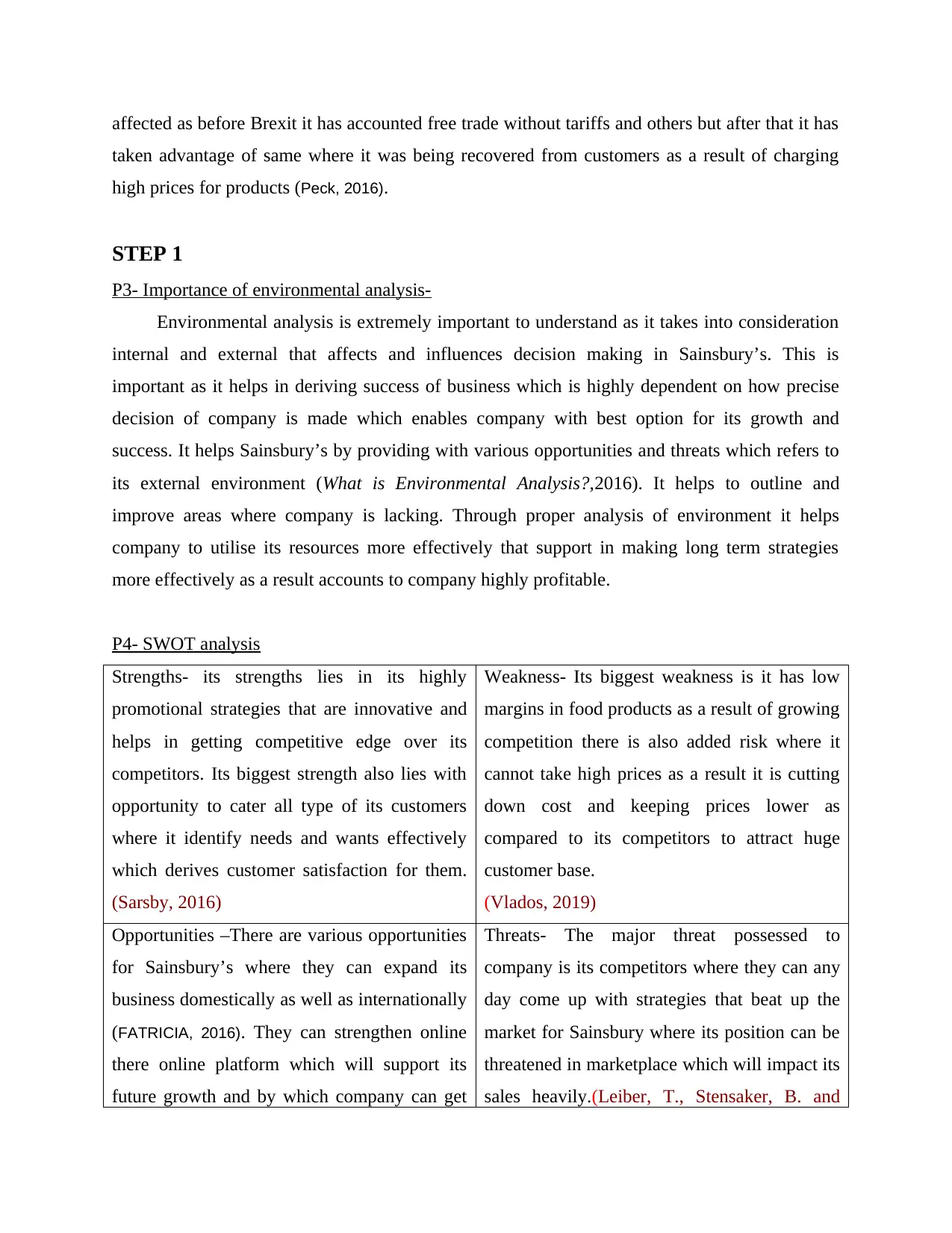
affected as before Brexit it has accounted free trade without tariffs and others but after that it has
taken advantage of same where it was being recovered from customers as a result of charging
high prices for products (Peck, 2016).
STEP 1
P3- Importance of environmental analysis-
Environmental analysis is extremely important to understand as it takes into consideration
internal and external that affects and influences decision making in Sainsbury’s. This is
important as it helps in deriving success of business which is highly dependent on how precise
decision of company is made which enables company with best option for its growth and
success. It helps Sainsbury’s by providing with various opportunities and threats which refers to
its external environment (What is Environmental Analysis?,2016). It helps to outline and
improve areas where company is lacking. Through proper analysis of environment it helps
company to utilise its resources more effectively that support in making long term strategies
more effectively as a result accounts to company highly profitable.
P4- SWOT analysis
Strengths- its strengths lies in its highly
promotional strategies that are innovative and
helps in getting competitive edge over its
competitors. Its biggest strength also lies with
opportunity to cater all type of its customers
where it identify needs and wants effectively
which derives customer satisfaction for them.
(Sarsby, 2016)
Weakness- Its biggest weakness is it has low
margins in food products as a result of growing
competition there is also added risk where it
cannot take high prices as a result it is cutting
down cost and keeping prices lower as
compared to its competitors to attract huge
customer base.
(Vlados, 2019)
Opportunities –There are various opportunities
for Sainsbury’s where they can expand its
business domestically as well as internationally
(FATRICIA, 2016). They can strengthen online
there online platform which will support its
future growth and by which company can get
Threats- The major threat possessed to
company is its competitors where they can any
day come up with strategies that beat up the
market for Sainsbury where its position can be
threatened in marketplace which will impact its
sales heavily.(Leiber, T., Stensaker, B. and
taken advantage of same where it was being recovered from customers as a result of charging
high prices for products (Peck, 2016).
STEP 1
P3- Importance of environmental analysis-
Environmental analysis is extremely important to understand as it takes into consideration
internal and external that affects and influences decision making in Sainsbury’s. This is
important as it helps in deriving success of business which is highly dependent on how precise
decision of company is made which enables company with best option for its growth and
success. It helps Sainsbury’s by providing with various opportunities and threats which refers to
its external environment (What is Environmental Analysis?,2016). It helps to outline and
improve areas where company is lacking. Through proper analysis of environment it helps
company to utilise its resources more effectively that support in making long term strategies
more effectively as a result accounts to company highly profitable.
P4- SWOT analysis
Strengths- its strengths lies in its highly
promotional strategies that are innovative and
helps in getting competitive edge over its
competitors. Its biggest strength also lies with
opportunity to cater all type of its customers
where it identify needs and wants effectively
which derives customer satisfaction for them.
(Sarsby, 2016)
Weakness- Its biggest weakness is it has low
margins in food products as a result of growing
competition there is also added risk where it
cannot take high prices as a result it is cutting
down cost and keeping prices lower as
compared to its competitors to attract huge
customer base.
(Vlados, 2019)
Opportunities –There are various opportunities
for Sainsbury’s where they can expand its
business domestically as well as internationally
(FATRICIA, 2016). They can strengthen online
there online platform which will support its
future growth and by which company can get
Threats- The major threat possessed to
company is its competitors where they can any
day come up with strategies that beat up the
market for Sainsbury where its position can be
threatened in marketplace which will impact its
sales heavily.(Leiber, T., Stensaker, B. and
Paraphrase This Document
Need a fresh take? Get an instant paraphrase of this document with our AI Paraphraser
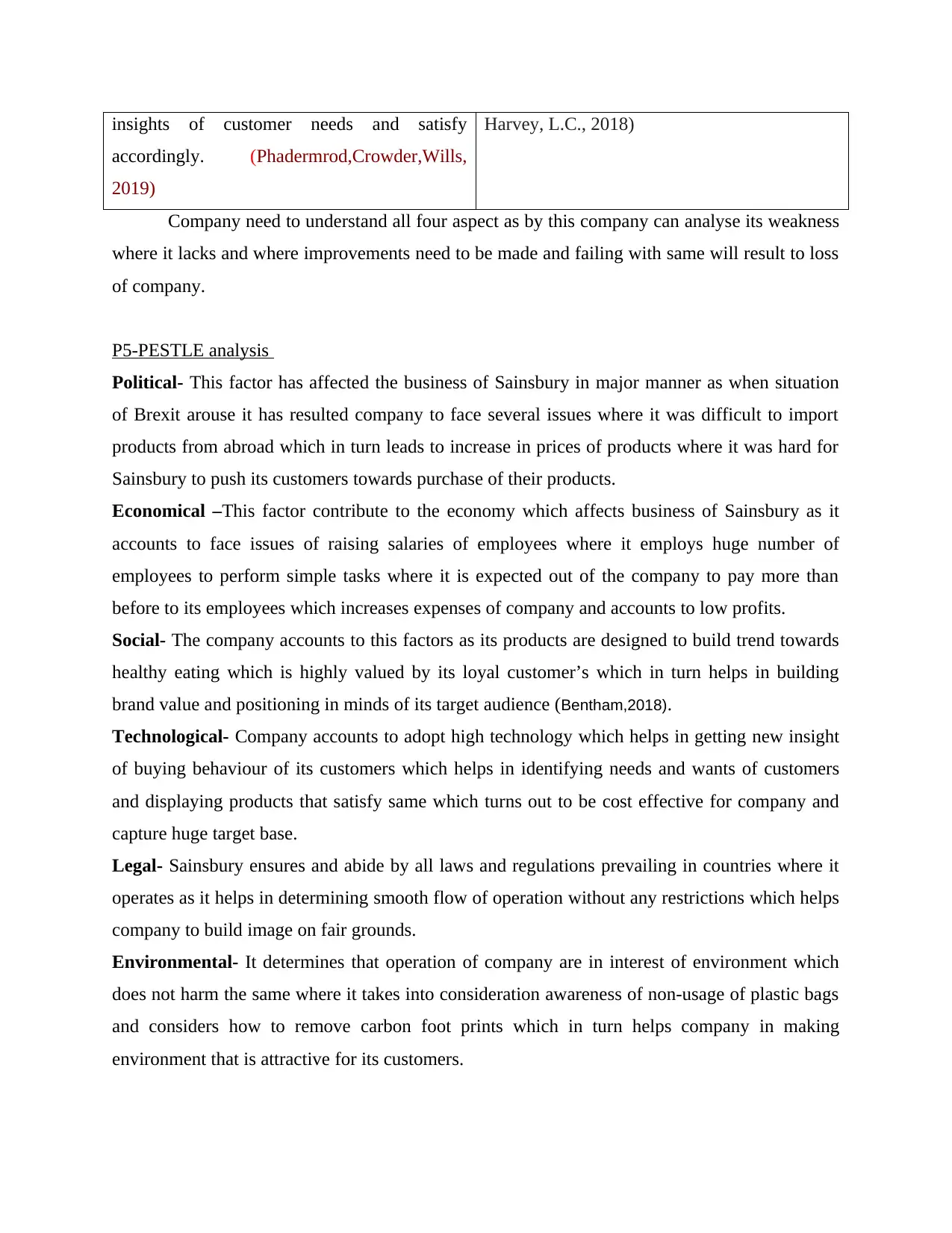
insights of customer needs and satisfy
accordingly. (Phadermrod,Crowder,Wills,
2019)
Harvey, L.C., 2018)
Company need to understand all four aspect as by this company can analyse its weakness
where it lacks and where improvements need to be made and failing with same will result to loss
of company.
P5-PESTLE analysis
Political- This factor has affected the business of Sainsbury in major manner as when situation
of Brexit arouse it has resulted company to face several issues where it was difficult to import
products from abroad which in turn leads to increase in prices of products where it was hard for
Sainsbury to push its customers towards purchase of their products.
Economical –This factor contribute to the economy which affects business of Sainsbury as it
accounts to face issues of raising salaries of employees where it employs huge number of
employees to perform simple tasks where it is expected out of the company to pay more than
before to its employees which increases expenses of company and accounts to low profits.
Social- The company accounts to this factors as its products are designed to build trend towards
healthy eating which is highly valued by its loyal customer’s which in turn helps in building
brand value and positioning in minds of its target audience (Bentham,2018).
Technological- Company accounts to adopt high technology which helps in getting new insight
of buying behaviour of its customers which helps in identifying needs and wants of customers
and displaying products that satisfy same which turns out to be cost effective for company and
capture huge target base.
Legal- Sainsbury ensures and abide by all laws and regulations prevailing in countries where it
operates as it helps in determining smooth flow of operation without any restrictions which helps
company to build image on fair grounds.
Environmental- It determines that operation of company are in interest of environment which
does not harm the same where it takes into consideration awareness of non-usage of plastic bags
and considers how to remove carbon foot prints which in turn helps company in making
environment that is attractive for its customers.
accordingly. (Phadermrod,Crowder,Wills,
2019)
Harvey, L.C., 2018)
Company need to understand all four aspect as by this company can analyse its weakness
where it lacks and where improvements need to be made and failing with same will result to loss
of company.
P5-PESTLE analysis
Political- This factor has affected the business of Sainsbury in major manner as when situation
of Brexit arouse it has resulted company to face several issues where it was difficult to import
products from abroad which in turn leads to increase in prices of products where it was hard for
Sainsbury to push its customers towards purchase of their products.
Economical –This factor contribute to the economy which affects business of Sainsbury as it
accounts to face issues of raising salaries of employees where it employs huge number of
employees to perform simple tasks where it is expected out of the company to pay more than
before to its employees which increases expenses of company and accounts to low profits.
Social- The company accounts to this factors as its products are designed to build trend towards
healthy eating which is highly valued by its loyal customer’s which in turn helps in building
brand value and positioning in minds of its target audience (Bentham,2018).
Technological- Company accounts to adopt high technology which helps in getting new insight
of buying behaviour of its customers which helps in identifying needs and wants of customers
and displaying products that satisfy same which turns out to be cost effective for company and
capture huge target base.
Legal- Sainsbury ensures and abide by all laws and regulations prevailing in countries where it
operates as it helps in determining smooth flow of operation without any restrictions which helps
company to build image on fair grounds.
Environmental- It determines that operation of company are in interest of environment which
does not harm the same where it takes into consideration awareness of non-usage of plastic bags
and considers how to remove carbon foot prints which in turn helps company in making
environment that is attractive for its customers.
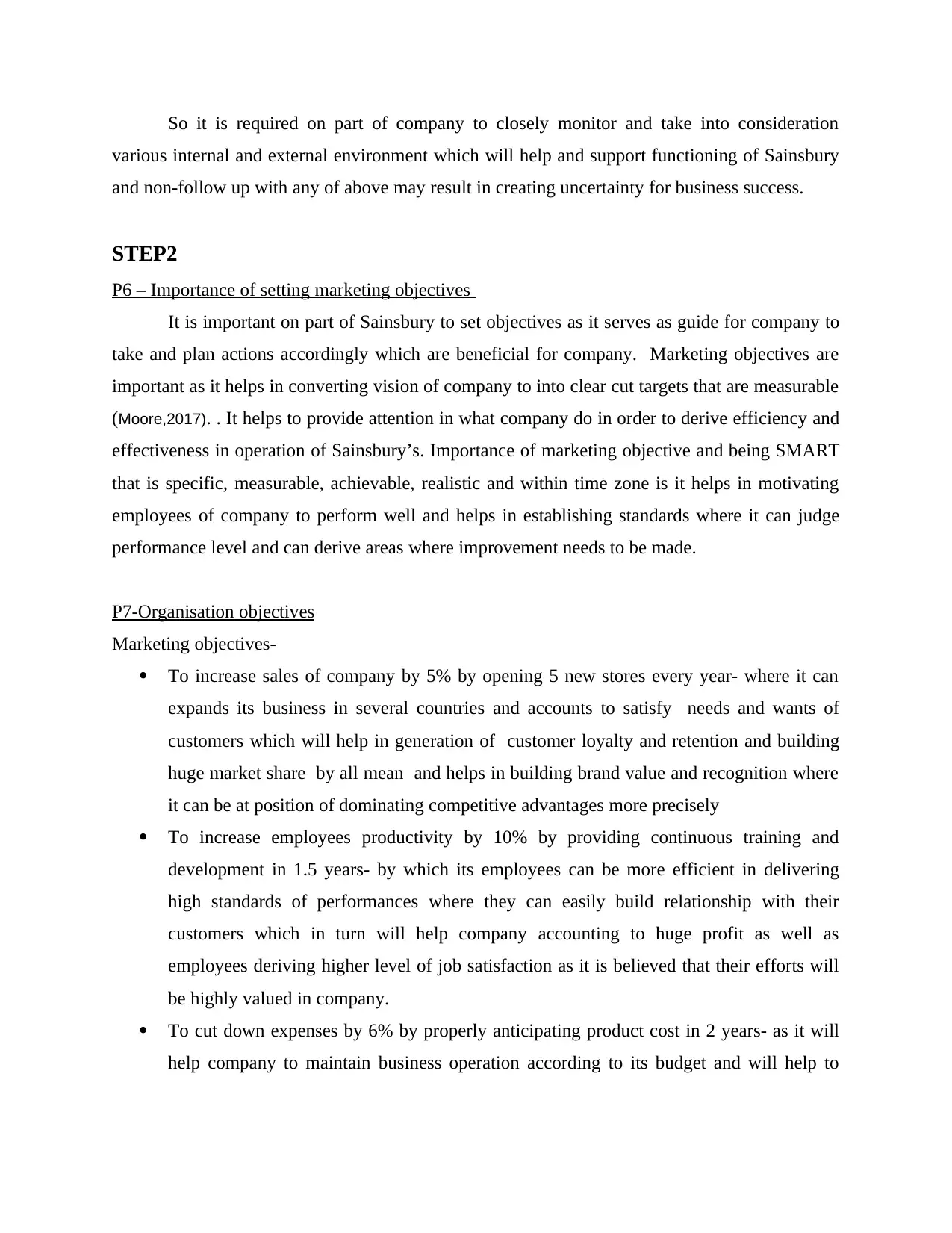
So it is required on part of company to closely monitor and take into consideration
various internal and external environment which will help and support functioning of Sainsbury
and non-follow up with any of above may result in creating uncertainty for business success.
STEP2
P6 – Importance of setting marketing objectives
It is important on part of Sainsbury to set objectives as it serves as guide for company to
take and plan actions accordingly which are beneficial for company. Marketing objectives are
important as it helps in converting vision of company to into clear cut targets that are measurable
(Moore,2017). . It helps to provide attention in what company do in order to derive efficiency and
effectiveness in operation of Sainsbury’s. Importance of marketing objective and being SMART
that is specific, measurable, achievable, realistic and within time zone is it helps in motivating
employees of company to perform well and helps in establishing standards where it can judge
performance level and can derive areas where improvement needs to be made.
P7-Organisation objectives
Marketing objectives-
To increase sales of company by 5% by opening 5 new stores every year- where it can
expands its business in several countries and accounts to satisfy needs and wants of
customers which will help in generation of customer loyalty and retention and building
huge market share by all mean and helps in building brand value and recognition where
it can be at position of dominating competitive advantages more precisely
To increase employees productivity by 10% by providing continuous training and
development in 1.5 years- by which its employees can be more efficient in delivering
high standards of performances where they can easily build relationship with their
customers which in turn will help company accounting to huge profit as well as
employees deriving higher level of job satisfaction as it is believed that their efforts will
be highly valued in company.
To cut down expenses by 6% by properly anticipating product cost in 2 years- as it will
help company to maintain business operation according to its budget and will help to
various internal and external environment which will help and support functioning of Sainsbury
and non-follow up with any of above may result in creating uncertainty for business success.
STEP2
P6 – Importance of setting marketing objectives
It is important on part of Sainsbury to set objectives as it serves as guide for company to
take and plan actions accordingly which are beneficial for company. Marketing objectives are
important as it helps in converting vision of company to into clear cut targets that are measurable
(Moore,2017). . It helps to provide attention in what company do in order to derive efficiency and
effectiveness in operation of Sainsbury’s. Importance of marketing objective and being SMART
that is specific, measurable, achievable, realistic and within time zone is it helps in motivating
employees of company to perform well and helps in establishing standards where it can judge
performance level and can derive areas where improvement needs to be made.
P7-Organisation objectives
Marketing objectives-
To increase sales of company by 5% by opening 5 new stores every year- where it can
expands its business in several countries and accounts to satisfy needs and wants of
customers which will help in generation of customer loyalty and retention and building
huge market share by all mean and helps in building brand value and recognition where
it can be at position of dominating competitive advantages more precisely
To increase employees productivity by 10% by providing continuous training and
development in 1.5 years- by which its employees can be more efficient in delivering
high standards of performances where they can easily build relationship with their
customers which in turn will help company accounting to huge profit as well as
employees deriving higher level of job satisfaction as it is believed that their efforts will
be highly valued in company.
To cut down expenses by 6% by properly anticipating product cost in 2 years- as it will
help company to maintain business operation according to its budget and will help to
⊘ This is a preview!⊘
Do you want full access?
Subscribe today to unlock all pages.

Trusted by 1+ million students worldwide
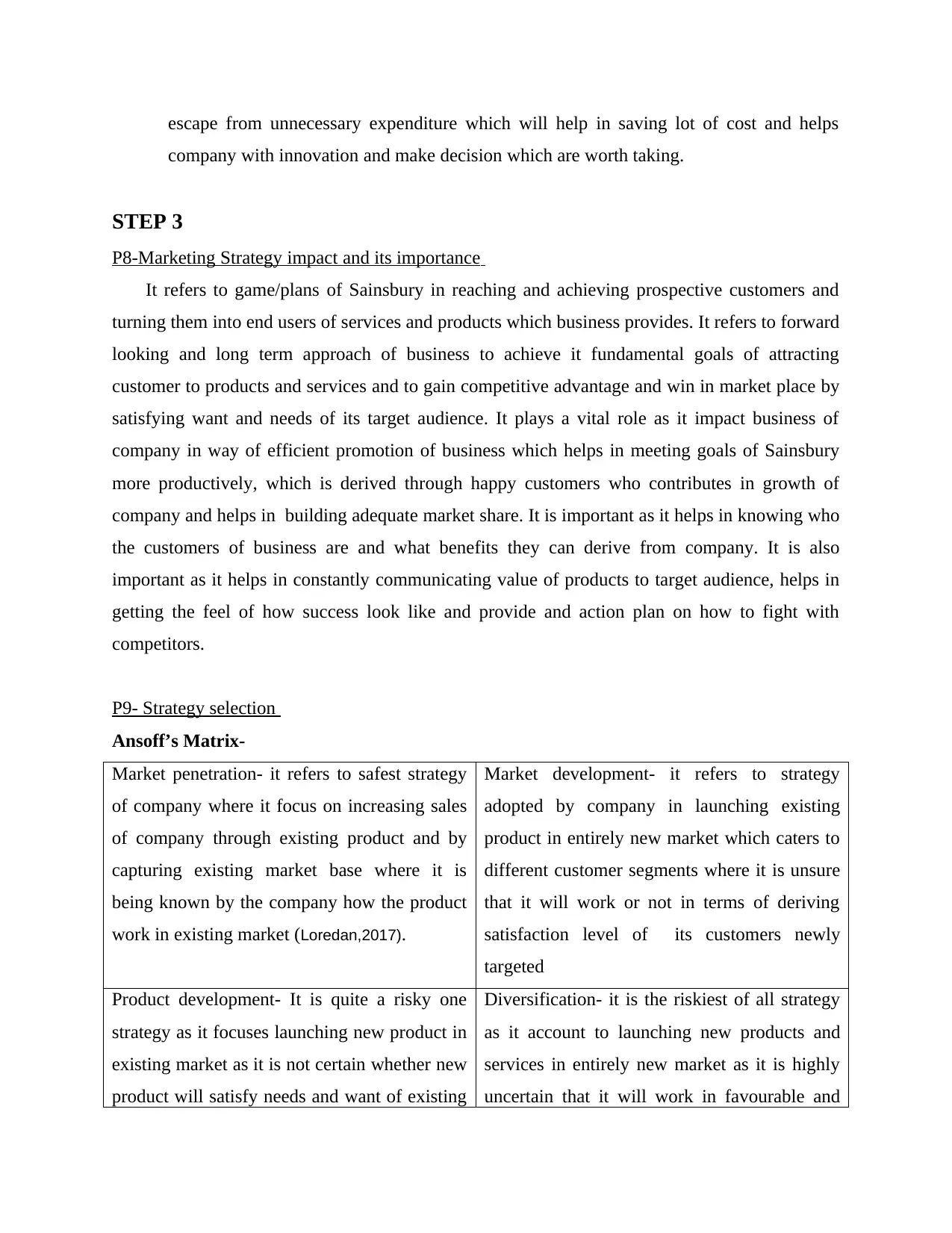
escape from unnecessary expenditure which will help in saving lot of cost and helps
company with innovation and make decision which are worth taking.
STEP 3
P8-Marketing Strategy impact and its importance
It refers to game/plans of Sainsbury in reaching and achieving prospective customers and
turning them into end users of services and products which business provides. It refers to forward
looking and long term approach of business to achieve it fundamental goals of attracting
customer to products and services and to gain competitive advantage and win in market place by
satisfying want and needs of its target audience. It plays a vital role as it impact business of
company in way of efficient promotion of business which helps in meeting goals of Sainsbury
more productively, which is derived through happy customers who contributes in growth of
company and helps in building adequate market share. It is important as it helps in knowing who
the customers of business are and what benefits they can derive from company. It is also
important as it helps in constantly communicating value of products to target audience, helps in
getting the feel of how success look like and provide and action plan on how to fight with
competitors.
P9- Strategy selection
Ansoff’s Matrix-
Market penetration- it refers to safest strategy
of company where it focus on increasing sales
of company through existing product and by
capturing existing market base where it is
being known by the company how the product
work in existing market (Loredan,2017).
Market development- it refers to strategy
adopted by company in launching existing
product in entirely new market which caters to
different customer segments where it is unsure
that it will work or not in terms of deriving
satisfaction level of its customers newly
targeted
Product development- It is quite a risky one
strategy as it focuses launching new product in
existing market as it is not certain whether new
product will satisfy needs and want of existing
Diversification- it is the riskiest of all strategy
as it account to launching new products and
services in entirely new market as it is highly
uncertain that it will work in favourable and
company with innovation and make decision which are worth taking.
STEP 3
P8-Marketing Strategy impact and its importance
It refers to game/plans of Sainsbury in reaching and achieving prospective customers and
turning them into end users of services and products which business provides. It refers to forward
looking and long term approach of business to achieve it fundamental goals of attracting
customer to products and services and to gain competitive advantage and win in market place by
satisfying want and needs of its target audience. It plays a vital role as it impact business of
company in way of efficient promotion of business which helps in meeting goals of Sainsbury
more productively, which is derived through happy customers who contributes in growth of
company and helps in building adequate market share. It is important as it helps in knowing who
the customers of business are and what benefits they can derive from company. It is also
important as it helps in constantly communicating value of products to target audience, helps in
getting the feel of how success look like and provide and action plan on how to fight with
competitors.
P9- Strategy selection
Ansoff’s Matrix-
Market penetration- it refers to safest strategy
of company where it focus on increasing sales
of company through existing product and by
capturing existing market base where it is
being known by the company how the product
work in existing market (Loredan,2017).
Market development- it refers to strategy
adopted by company in launching existing
product in entirely new market which caters to
different customer segments where it is unsure
that it will work or not in terms of deriving
satisfaction level of its customers newly
targeted
Product development- It is quite a risky one
strategy as it focuses launching new product in
existing market as it is not certain whether new
product will satisfy needs and want of existing
Diversification- it is the riskiest of all strategy
as it account to launching new products and
services in entirely new market as it is highly
uncertain that it will work in favourable and
Paraphrase This Document
Need a fresh take? Get an instant paraphrase of this document with our AI Paraphraser
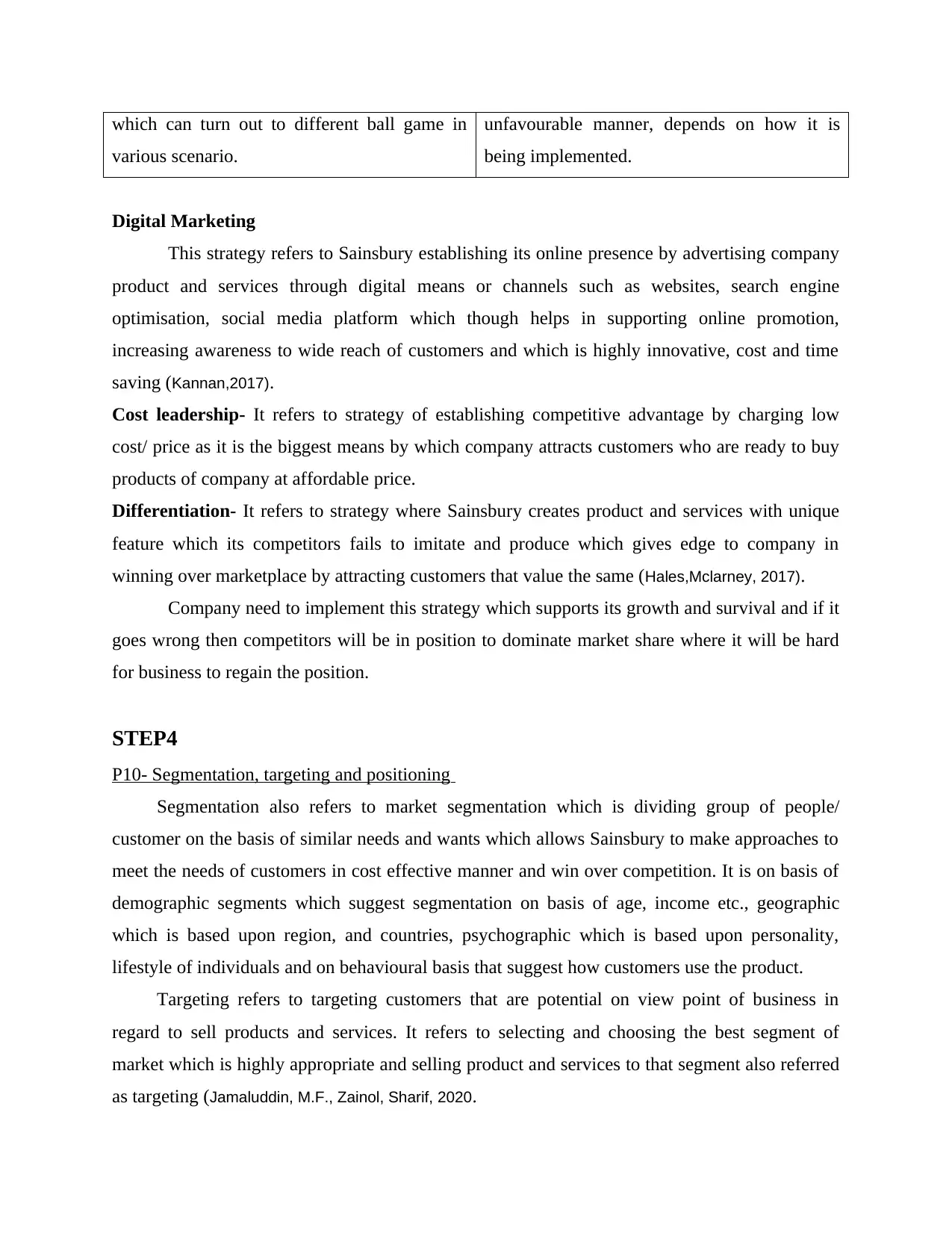
which can turn out to different ball game in
various scenario.
unfavourable manner, depends on how it is
being implemented.
Digital Marketing
This strategy refers to Sainsbury establishing its online presence by advertising company
product and services through digital means or channels such as websites, search engine
optimisation, social media platform which though helps in supporting online promotion,
increasing awareness to wide reach of customers and which is highly innovative, cost and time
saving (Kannan,2017).
Cost leadership- It refers to strategy of establishing competitive advantage by charging low
cost/ price as it is the biggest means by which company attracts customers who are ready to buy
products of company at affordable price.
Differentiation- It refers to strategy where Sainsbury creates product and services with unique
feature which its competitors fails to imitate and produce which gives edge to company in
winning over marketplace by attracting customers that value the same (Hales,Mclarney, 2017).
Company need to implement this strategy which supports its growth and survival and if it
goes wrong then competitors will be in position to dominate market share where it will be hard
for business to regain the position.
STEP4
P10- Segmentation, targeting and positioning
Segmentation also refers to market segmentation which is dividing group of people/
customer on the basis of similar needs and wants which allows Sainsbury to make approaches to
meet the needs of customers in cost effective manner and win over competition. It is on basis of
demographic segments which suggest segmentation on basis of age, income etc., geographic
which is based upon region, and countries, psychographic which is based upon personality,
lifestyle of individuals and on behavioural basis that suggest how customers use the product.
Targeting refers to targeting customers that are potential on view point of business in
regard to sell products and services. It refers to selecting and choosing the best segment of
market which is highly appropriate and selling product and services to that segment also referred
as targeting (Jamaluddin, M.F., Zainol, Sharif, 2020.
various scenario.
unfavourable manner, depends on how it is
being implemented.
Digital Marketing
This strategy refers to Sainsbury establishing its online presence by advertising company
product and services through digital means or channels such as websites, search engine
optimisation, social media platform which though helps in supporting online promotion,
increasing awareness to wide reach of customers and which is highly innovative, cost and time
saving (Kannan,2017).
Cost leadership- It refers to strategy of establishing competitive advantage by charging low
cost/ price as it is the biggest means by which company attracts customers who are ready to buy
products of company at affordable price.
Differentiation- It refers to strategy where Sainsbury creates product and services with unique
feature which its competitors fails to imitate and produce which gives edge to company in
winning over marketplace by attracting customers that value the same (Hales,Mclarney, 2017).
Company need to implement this strategy which supports its growth and survival and if it
goes wrong then competitors will be in position to dominate market share where it will be hard
for business to regain the position.
STEP4
P10- Segmentation, targeting and positioning
Segmentation also refers to market segmentation which is dividing group of people/
customer on the basis of similar needs and wants which allows Sainsbury to make approaches to
meet the needs of customers in cost effective manner and win over competition. It is on basis of
demographic segments which suggest segmentation on basis of age, income etc., geographic
which is based upon region, and countries, psychographic which is based upon personality,
lifestyle of individuals and on behavioural basis that suggest how customers use the product.
Targeting refers to targeting customers that are potential on view point of business in
regard to sell products and services. It refers to selecting and choosing the best segment of
market which is highly appropriate and selling product and services to that segment also referred
as targeting (Jamaluddin, M.F., Zainol, Sharif, 2020.
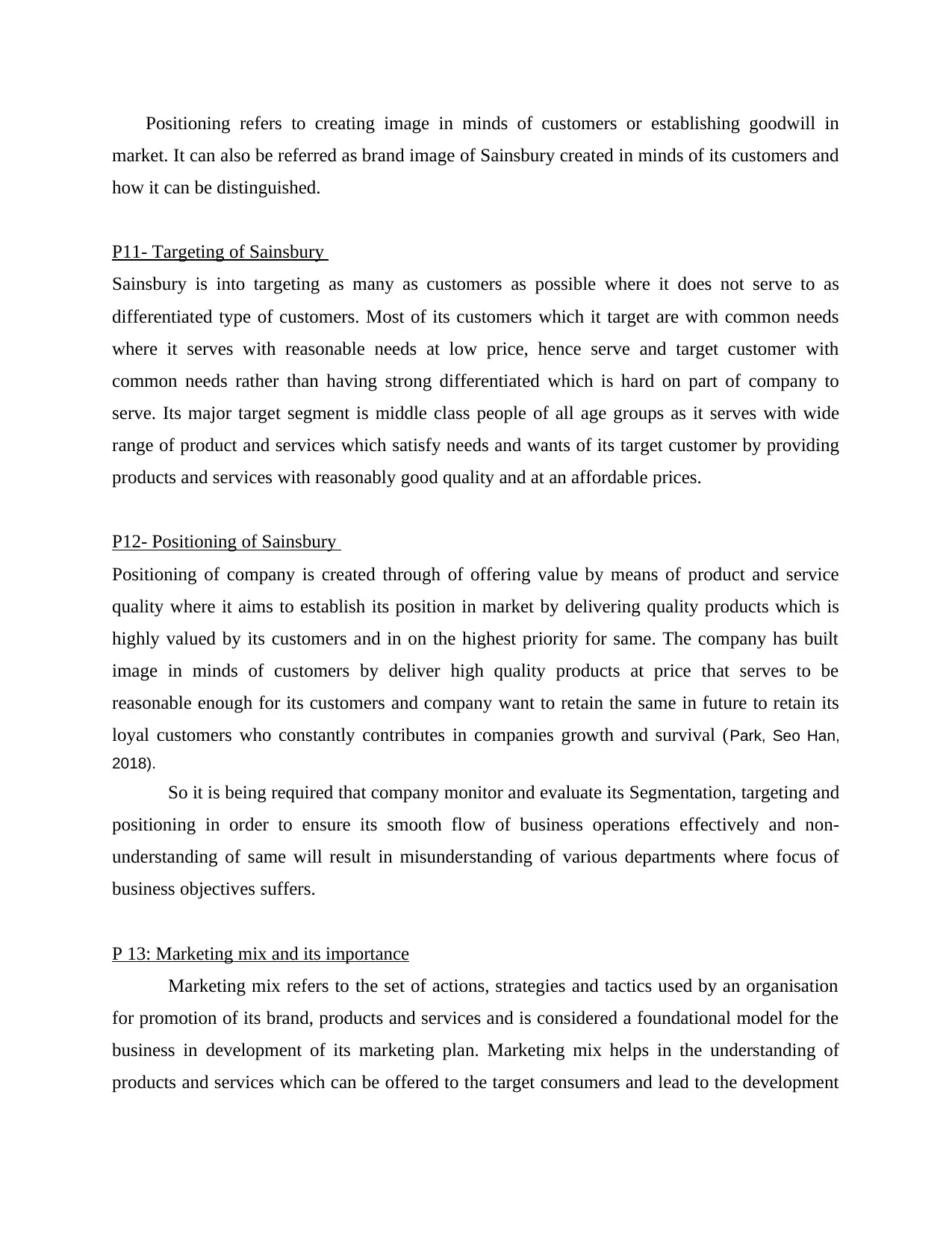
Positioning refers to creating image in minds of customers or establishing goodwill in
market. It can also be referred as brand image of Sainsbury created in minds of its customers and
how it can be distinguished.
P11- Targeting of Sainsbury
Sainsbury is into targeting as many as customers as possible where it does not serve to as
differentiated type of customers. Most of its customers which it target are with common needs
where it serves with reasonable needs at low price, hence serve and target customer with
common needs rather than having strong differentiated which is hard on part of company to
serve. Its major target segment is middle class people of all age groups as it serves with wide
range of product and services which satisfy needs and wants of its target customer by providing
products and services with reasonably good quality and at an affordable prices.
P12- Positioning of Sainsbury
Positioning of company is created through of offering value by means of product and service
quality where it aims to establish its position in market by delivering quality products which is
highly valued by its customers and in on the highest priority for same. The company has built
image in minds of customers by deliver high quality products at price that serves to be
reasonable enough for its customers and company want to retain the same in future to retain its
loyal customers who constantly contributes in companies growth and survival (Park, Seo Han,
2018).
So it is being required that company monitor and evaluate its Segmentation, targeting and
positioning in order to ensure its smooth flow of business operations effectively and non-
understanding of same will result in misunderstanding of various departments where focus of
business objectives suffers.
P 13: Marketing mix and its importance
Marketing mix refers to the set of actions, strategies and tactics used by an organisation
for promotion of its brand, products and services and is considered a foundational model for the
business in development of its marketing plan. Marketing mix helps in the understanding of
products and services which can be offered to the target consumers and lead to the development
market. It can also be referred as brand image of Sainsbury created in minds of its customers and
how it can be distinguished.
P11- Targeting of Sainsbury
Sainsbury is into targeting as many as customers as possible where it does not serve to as
differentiated type of customers. Most of its customers which it target are with common needs
where it serves with reasonable needs at low price, hence serve and target customer with
common needs rather than having strong differentiated which is hard on part of company to
serve. Its major target segment is middle class people of all age groups as it serves with wide
range of product and services which satisfy needs and wants of its target customer by providing
products and services with reasonably good quality and at an affordable prices.
P12- Positioning of Sainsbury
Positioning of company is created through of offering value by means of product and service
quality where it aims to establish its position in market by delivering quality products which is
highly valued by its customers and in on the highest priority for same. The company has built
image in minds of customers by deliver high quality products at price that serves to be
reasonable enough for its customers and company want to retain the same in future to retain its
loyal customers who constantly contributes in companies growth and survival (Park, Seo Han,
2018).
So it is being required that company monitor and evaluate its Segmentation, targeting and
positioning in order to ensure its smooth flow of business operations effectively and non-
understanding of same will result in misunderstanding of various departments where focus of
business objectives suffers.
P 13: Marketing mix and its importance
Marketing mix refers to the set of actions, strategies and tactics used by an organisation
for promotion of its brand, products and services and is considered a foundational model for the
business in development of its marketing plan. Marketing mix helps in the understanding of
products and services which can be offered to the target consumers and lead to the development
⊘ This is a preview!⊘
Do you want full access?
Subscribe today to unlock all pages.

Trusted by 1+ million students worldwide
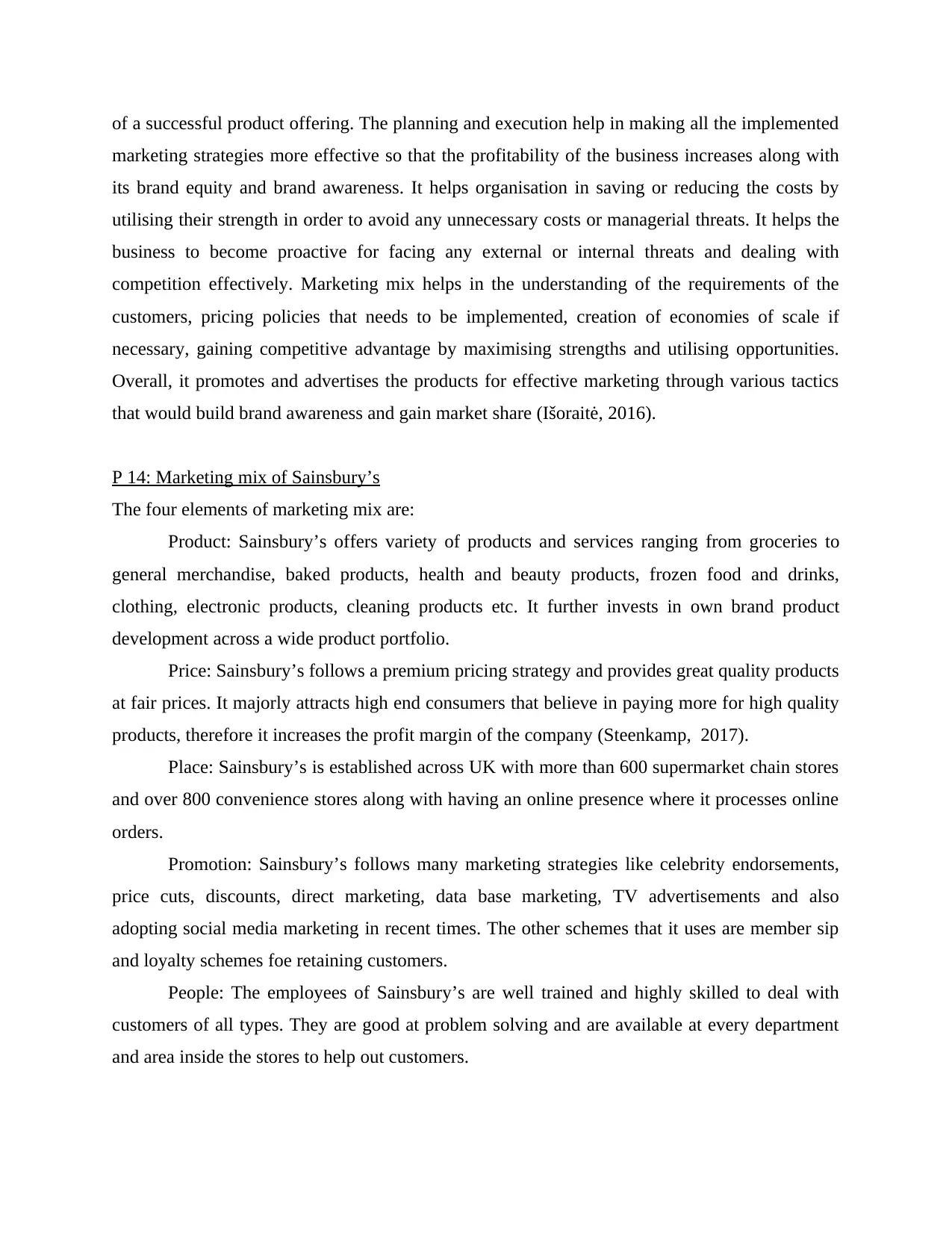
of a successful product offering. The planning and execution help in making all the implemented
marketing strategies more effective so that the profitability of the business increases along with
its brand equity and brand awareness. It helps organisation in saving or reducing the costs by
utilising their strength in order to avoid any unnecessary costs or managerial threats. It helps the
business to become proactive for facing any external or internal threats and dealing with
competition effectively. Marketing mix helps in the understanding of the requirements of the
customers, pricing policies that needs to be implemented, creation of economies of scale if
necessary, gaining competitive advantage by maximising strengths and utilising opportunities.
Overall, it promotes and advertises the products for effective marketing through various tactics
that would build brand awareness and gain market share (Išoraitė, 2016).
P 14: Marketing mix of Sainsbury’s
The four elements of marketing mix are:
Product: Sainsbury’s offers variety of products and services ranging from groceries to
general merchandise, baked products, health and beauty products, frozen food and drinks,
clothing, electronic products, cleaning products etc. It further invests in own brand product
development across a wide product portfolio.
Price: Sainsbury’s follows a premium pricing strategy and provides great quality products
at fair prices. It majorly attracts high end consumers that believe in paying more for high quality
products, therefore it increases the profit margin of the company (Steenkamp, 2017).
Place: Sainsbury’s is established across UK with more than 600 supermarket chain stores
and over 800 convenience stores along with having an online presence where it processes online
orders.
Promotion: Sainsbury’s follows many marketing strategies like celebrity endorsements,
price cuts, discounts, direct marketing, data base marketing, TV advertisements and also
adopting social media marketing in recent times. The other schemes that it uses are member sip
and loyalty schemes foe retaining customers.
People: The employees of Sainsbury’s are well trained and highly skilled to deal with
customers of all types. They are good at problem solving and are available at every department
and area inside the stores to help out customers.
marketing strategies more effective so that the profitability of the business increases along with
its brand equity and brand awareness. It helps organisation in saving or reducing the costs by
utilising their strength in order to avoid any unnecessary costs or managerial threats. It helps the
business to become proactive for facing any external or internal threats and dealing with
competition effectively. Marketing mix helps in the understanding of the requirements of the
customers, pricing policies that needs to be implemented, creation of economies of scale if
necessary, gaining competitive advantage by maximising strengths and utilising opportunities.
Overall, it promotes and advertises the products for effective marketing through various tactics
that would build brand awareness and gain market share (Išoraitė, 2016).
P 14: Marketing mix of Sainsbury’s
The four elements of marketing mix are:
Product: Sainsbury’s offers variety of products and services ranging from groceries to
general merchandise, baked products, health and beauty products, frozen food and drinks,
clothing, electronic products, cleaning products etc. It further invests in own brand product
development across a wide product portfolio.
Price: Sainsbury’s follows a premium pricing strategy and provides great quality products
at fair prices. It majorly attracts high end consumers that believe in paying more for high quality
products, therefore it increases the profit margin of the company (Steenkamp, 2017).
Place: Sainsbury’s is established across UK with more than 600 supermarket chain stores
and over 800 convenience stores along with having an online presence where it processes online
orders.
Promotion: Sainsbury’s follows many marketing strategies like celebrity endorsements,
price cuts, discounts, direct marketing, data base marketing, TV advertisements and also
adopting social media marketing in recent times. The other schemes that it uses are member sip
and loyalty schemes foe retaining customers.
People: The employees of Sainsbury’s are well trained and highly skilled to deal with
customers of all types. They are good at problem solving and are available at every department
and area inside the stores to help out customers.
Paraphrase This Document
Need a fresh take? Get an instant paraphrase of this document with our AI Paraphraser
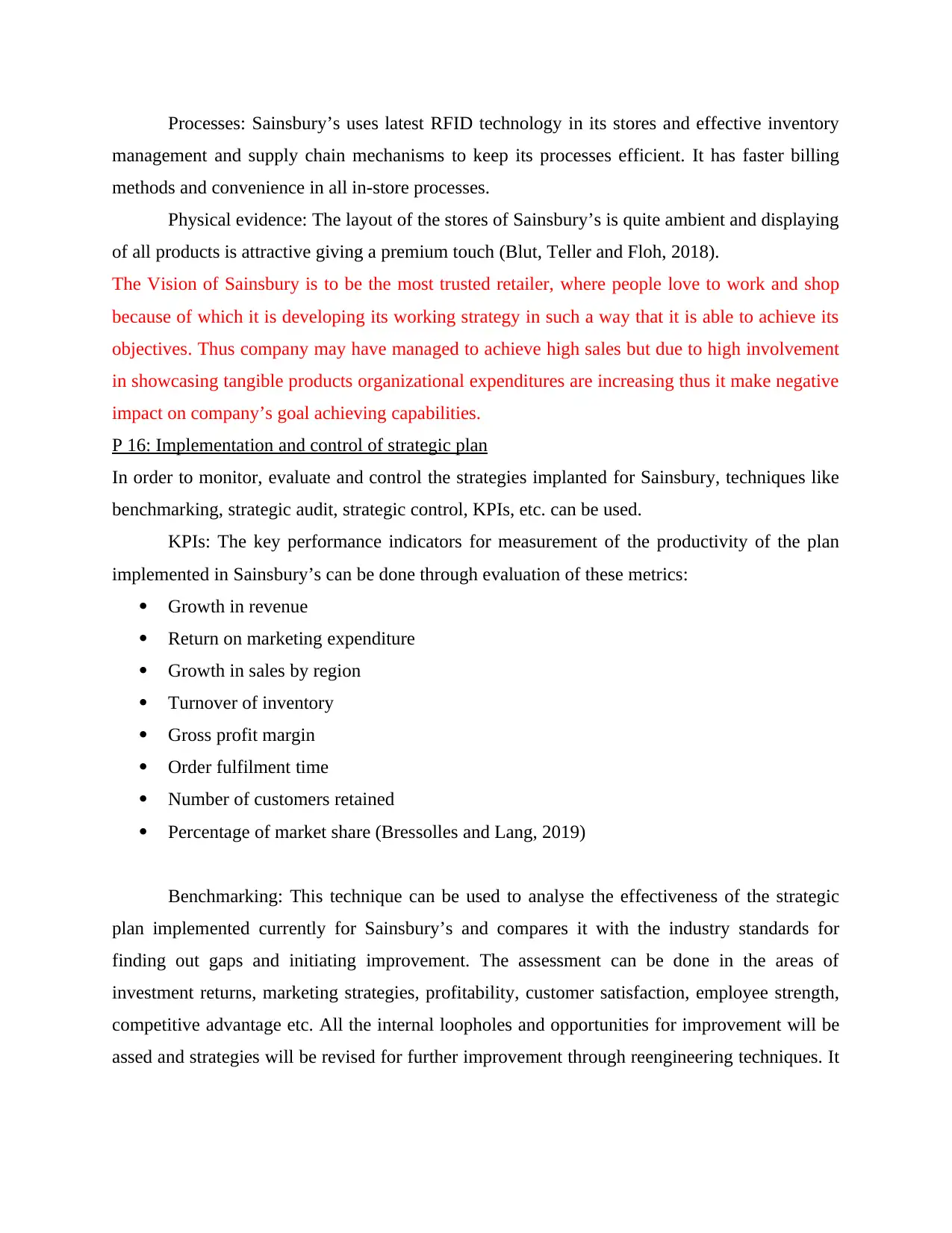
Processes: Sainsbury’s uses latest RFID technology in its stores and effective inventory
management and supply chain mechanisms to keep its processes efficient. It has faster billing
methods and convenience in all in-store processes.
Physical evidence: The layout of the stores of Sainsbury’s is quite ambient and displaying
of all products is attractive giving a premium touch (Blut, Teller and Floh, 2018).
The Vision of Sainsbury is to be the most trusted retailer, where people love to work and shop
because of which it is developing its working strategy in such a way that it is able to achieve its
objectives. Thus company may have managed to achieve high sales but due to high involvement
in showcasing tangible products organizational expenditures are increasing thus it make negative
impact on company’s goal achieving capabilities.
P 16: Implementation and control of strategic plan
In order to monitor, evaluate and control the strategies implanted for Sainsbury, techniques like
benchmarking, strategic audit, strategic control, KPIs, etc. can be used.
KPIs: The key performance indicators for measurement of the productivity of the plan
implemented in Sainsbury’s can be done through evaluation of these metrics:
Growth in revenue
Return on marketing expenditure
Growth in sales by region
Turnover of inventory
Gross profit margin
Order fulfilment time
Number of customers retained
Percentage of market share (Bressolles and Lang, 2019)
Benchmarking: This technique can be used to analyse the effectiveness of the strategic
plan implemented currently for Sainsbury’s and compares it with the industry standards for
finding out gaps and initiating improvement. The assessment can be done in the areas of
investment returns, marketing strategies, profitability, customer satisfaction, employee strength,
competitive advantage etc. All the internal loopholes and opportunities for improvement will be
assed and strategies will be revised for further improvement through reengineering techniques. It
management and supply chain mechanisms to keep its processes efficient. It has faster billing
methods and convenience in all in-store processes.
Physical evidence: The layout of the stores of Sainsbury’s is quite ambient and displaying
of all products is attractive giving a premium touch (Blut, Teller and Floh, 2018).
The Vision of Sainsbury is to be the most trusted retailer, where people love to work and shop
because of which it is developing its working strategy in such a way that it is able to achieve its
objectives. Thus company may have managed to achieve high sales but due to high involvement
in showcasing tangible products organizational expenditures are increasing thus it make negative
impact on company’s goal achieving capabilities.
P 16: Implementation and control of strategic plan
In order to monitor, evaluate and control the strategies implanted for Sainsbury, techniques like
benchmarking, strategic audit, strategic control, KPIs, etc. can be used.
KPIs: The key performance indicators for measurement of the productivity of the plan
implemented in Sainsbury’s can be done through evaluation of these metrics:
Growth in revenue
Return on marketing expenditure
Growth in sales by region
Turnover of inventory
Gross profit margin
Order fulfilment time
Number of customers retained
Percentage of market share (Bressolles and Lang, 2019)
Benchmarking: This technique can be used to analyse the effectiveness of the strategic
plan implemented currently for Sainsbury’s and compares it with the industry standards for
finding out gaps and initiating improvement. The assessment can be done in the areas of
investment returns, marketing strategies, profitability, customer satisfaction, employee strength,
competitive advantage etc. All the internal loopholes and opportunities for improvement will be
assed and strategies will be revised for further improvement through reengineering techniques. It
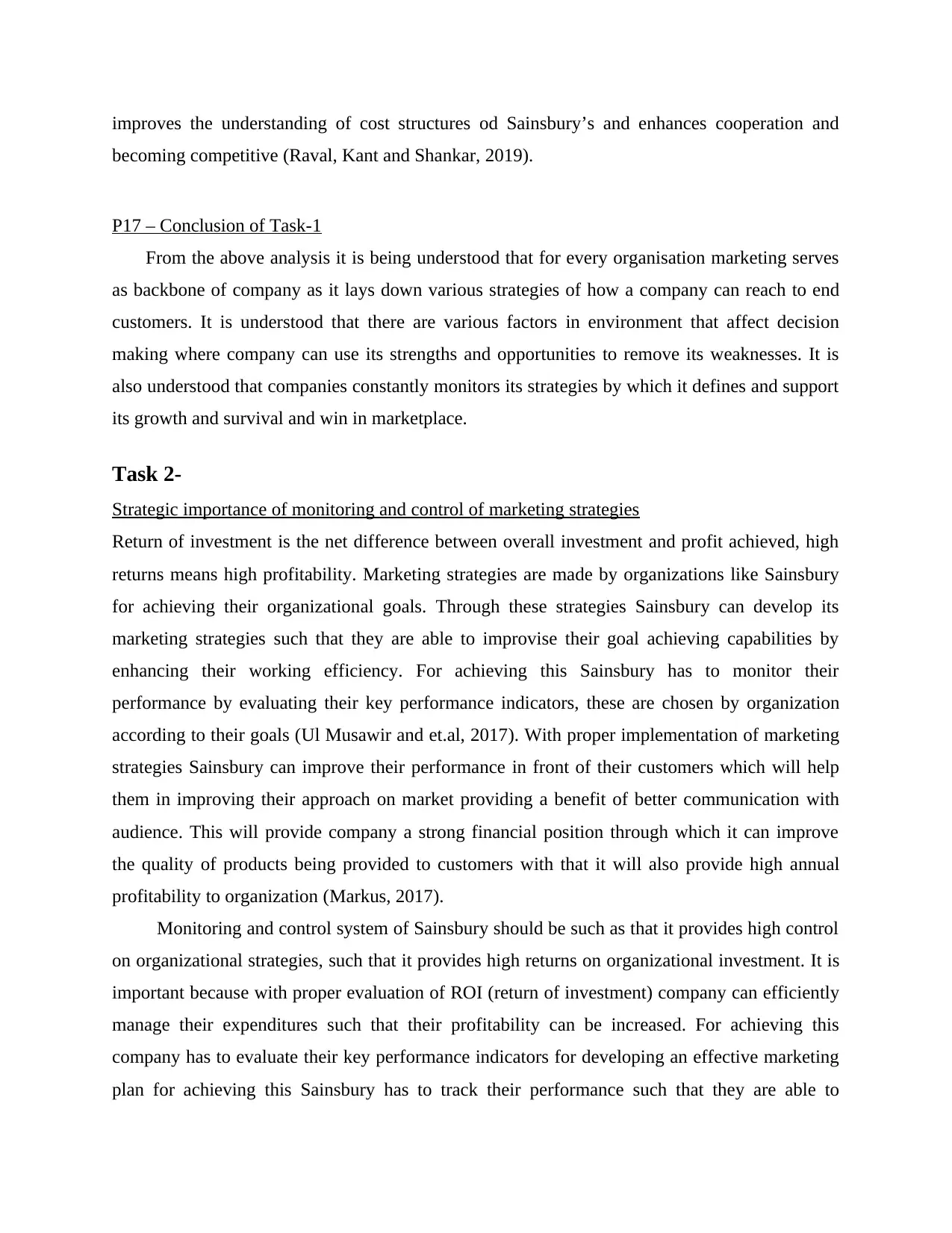
improves the understanding of cost structures od Sainsbury’s and enhances cooperation and
becoming competitive (Raval, Kant and Shankar, 2019).
P17 – Conclusion of Task-1
From the above analysis it is being understood that for every organisation marketing serves
as backbone of company as it lays down various strategies of how a company can reach to end
customers. It is understood that there are various factors in environment that affect decision
making where company can use its strengths and opportunities to remove its weaknesses. It is
also understood that companies constantly monitors its strategies by which it defines and support
its growth and survival and win in marketplace.
Task 2-
Strategic importance of monitoring and control of marketing strategies
Return of investment is the net difference between overall investment and profit achieved, high
returns means high profitability. Marketing strategies are made by organizations like Sainsbury
for achieving their organizational goals. Through these strategies Sainsbury can develop its
marketing strategies such that they are able to improvise their goal achieving capabilities by
enhancing their working efficiency. For achieving this Sainsbury has to monitor their
performance by evaluating their key performance indicators, these are chosen by organization
according to their goals (Ul Musawir and et.al, 2017). With proper implementation of marketing
strategies Sainsbury can improve their performance in front of their customers which will help
them in improving their approach on market providing a benefit of better communication with
audience. This will provide company a strong financial position through which it can improve
the quality of products being provided to customers with that it will also provide high annual
profitability to organization (Markus, 2017).
Monitoring and control system of Sainsbury should be such as that it provides high control
on organizational strategies, such that it provides high returns on organizational investment. It is
important because with proper evaluation of ROI (return of investment) company can efficiently
manage their expenditures such that their profitability can be increased. For achieving this
company has to evaluate their key performance indicators for developing an effective marketing
plan for achieving this Sainsbury has to track their performance such that they are able to
becoming competitive (Raval, Kant and Shankar, 2019).
P17 – Conclusion of Task-1
From the above analysis it is being understood that for every organisation marketing serves
as backbone of company as it lays down various strategies of how a company can reach to end
customers. It is understood that there are various factors in environment that affect decision
making where company can use its strengths and opportunities to remove its weaknesses. It is
also understood that companies constantly monitors its strategies by which it defines and support
its growth and survival and win in marketplace.
Task 2-
Strategic importance of monitoring and control of marketing strategies
Return of investment is the net difference between overall investment and profit achieved, high
returns means high profitability. Marketing strategies are made by organizations like Sainsbury
for achieving their organizational goals. Through these strategies Sainsbury can develop its
marketing strategies such that they are able to improvise their goal achieving capabilities by
enhancing their working efficiency. For achieving this Sainsbury has to monitor their
performance by evaluating their key performance indicators, these are chosen by organization
according to their goals (Ul Musawir and et.al, 2017). With proper implementation of marketing
strategies Sainsbury can improve their performance in front of their customers which will help
them in improving their approach on market providing a benefit of better communication with
audience. This will provide company a strong financial position through which it can improve
the quality of products being provided to customers with that it will also provide high annual
profitability to organization (Markus, 2017).
Monitoring and control system of Sainsbury should be such as that it provides high control
on organizational strategies, such that it provides high returns on organizational investment. It is
important because with proper evaluation of ROI (return of investment) company can efficiently
manage their expenditures such that their profitability can be increased. For achieving this
company has to evaluate their key performance indicators for developing an effective marketing
plan for achieving this Sainsbury has to track their performance such that they are able to
⊘ This is a preview!⊘
Do you want full access?
Subscribe today to unlock all pages.

Trusted by 1+ million students worldwide
1 out of 16
Related Documents
Your All-in-One AI-Powered Toolkit for Academic Success.
+13062052269
info@desklib.com
Available 24*7 on WhatsApp / Email
![[object Object]](/_next/static/media/star-bottom.7253800d.svg)
Unlock your academic potential
Copyright © 2020–2025 A2Z Services. All Rights Reserved. Developed and managed by ZUCOL.




